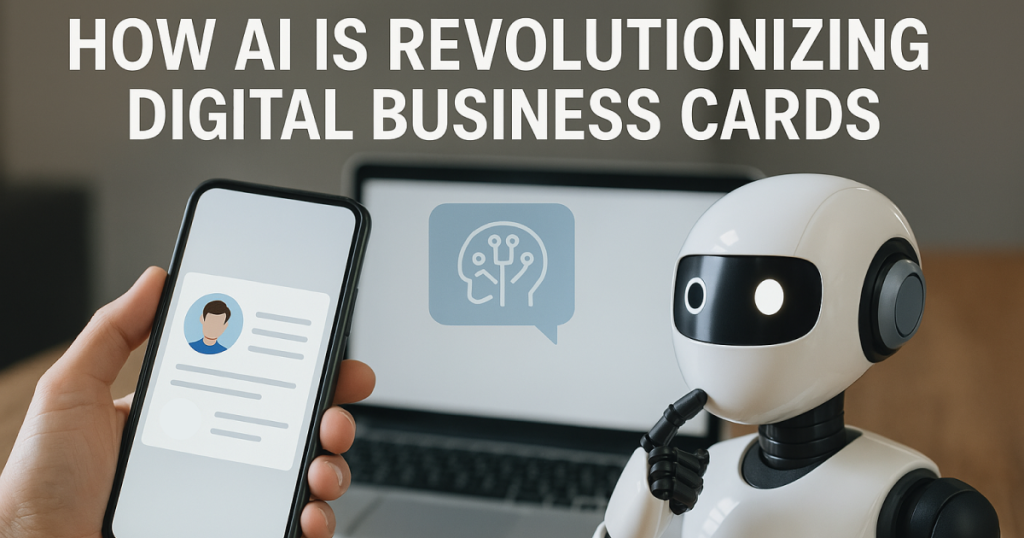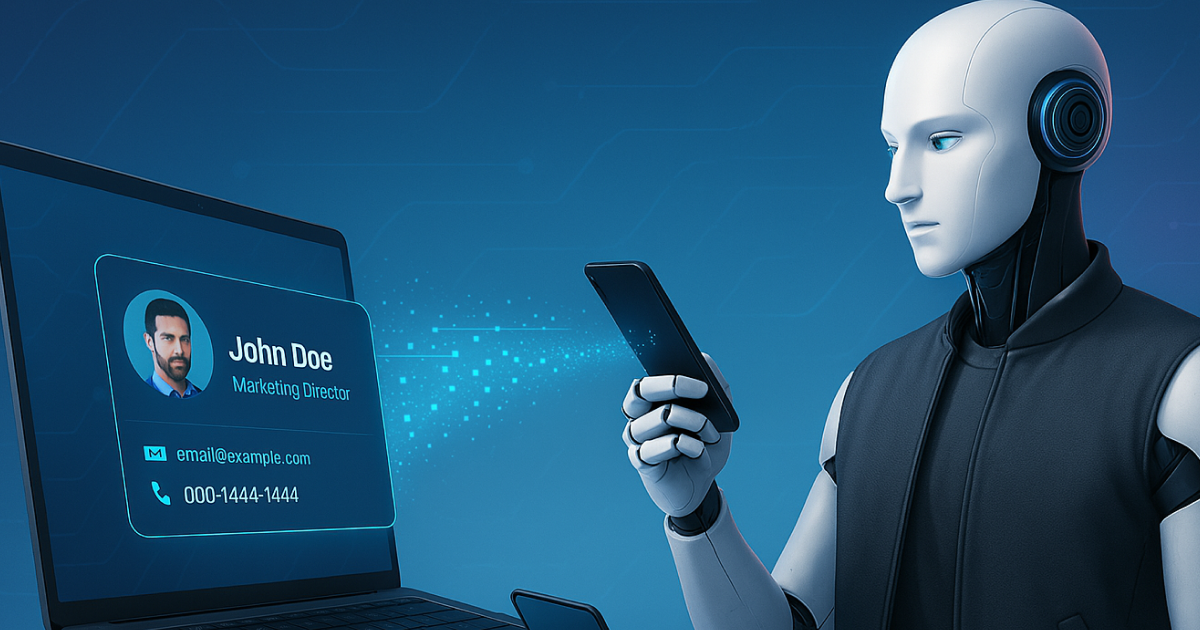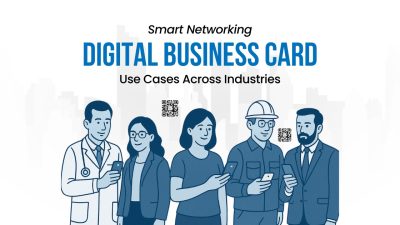Business cards have always been a big part of networking, but let’s be honest—printed cards often get lost, damaged, or tossed away. As our world moves faster and becomes more digital, the way we connect is changing too. This is where AI-powered business cards are stepping in to make networking smarter, more efficient, and more personal.
In recent years, the question of how AI is transforming digital business cards has gained significant attention.
Understanding how AI is transforming digital business cards is crucial for modern networking.
With AI transforming business communication, digital cards are no longer just static contact details. They’re dynamic, interactive tools that adapt to your needs. Whether you’re at a conference or connecting online, AI in digital networking is helping professionals make more meaningful and lasting impressions.
Ultimately, how AI is transforming digital business cards is reshaping the landscape of professional networking.
With all these advancements, how AI is transforming digital business cards has never been more relevant.
As we analyze how AI is transforming digital business cards, we can see clear benefits emerging for users.
One of the key areas where how AI is transforming digital business cards stands out is in personalization.
What Are Digital Business Cards & Why They Matter
Additionally, how AI is transforming digital business cards is evidenced by the rise of dynamic content updates.
Digital business cards, sometimes called virtual business cards, are modern, tech-savvy alternatives to traditional printed cards. Instead of handing out a piece of paper, you can now share your contact details through a QR code, a link, or even a quick tap between phones. These cards are stored digitally, which means you can access and share them anytime, from anywhere.
While the idea of digital business cards has been around for a while, they started gaining real traction after the COVID-19 pandemic. As in-person events were replaced by Zoom calls and virtual conferences, professionals began to look for safer, contactless ways to network. That’s when the digital card moved from being a “nice-to-have” to a real necessity.
Unlike physical cards, digital versions are easy to update. Change your job title, phone number, or website? You don’t need to reprint hundreds of cards—you just edit your card, and it’s instantly updated for everyone you’ve shared it with. They’re also more eco-friendly, helping reduce paper waste and the costs of reprinting every time something changes.
What makes them especially powerful today is how they can do more than just display your name and phone number. Many digital business cards can link to your LinkedIn profile, showcase your portfolio, include videos, and even integrate with calendars and CRMs. This kind of paperless networking brings a whole new level of interactivity and convenience that traditional cards simply can’t offer.
How AI Is Transforming Digital Business Cards – Discover How AI Is Transforming Digital Business Cards

We can see how AI is transforming digital business cards when we look at networking capabilities.
It’s not enough for a business card to simply exist—it needs to work for you. That’s where artificial intelligence (AI) is making a big impact. From smart design tools to intelligent networking features, AI is reshaping how we share, manage, and grow our professional presence.
1. Smart Design & Personalization
Furthermore, how AI is transforming digital business cards applies to lead capture and follow-up automation.
Design is the first impression your business card makes. But not everyone is a designer—and even fewer have time to figure out what layout best suits their profession. AI solves this by analyzing your industry, job title, brand colors, and even tone of voice to recommend a design that feels personalized and professional.
For example, a creative director might get a bold, visual layout, while a financial advisor might see something clean and minimalist. Some platforms even learn from your past preferences and adjust accordingly over time. This type of AI personalization goes beyond just looks—it helps you communicate your personal brand instantly and effectively.
In short, AI takes the guesswork out of designing a card that actually represents you.
2. Dynamic Content Updates
Keeping your contact information up to date is often overlooked—until someone tries to reach you on an old number. With AI-powered digital cards, your details can be automatically synced with real-time sources like LinkedIn, your work email, or your CRM.
That means your digital card evolves as you do. Got a promotion? New project? Updated website? Your card reflects it instantly, without you needing to resend anything. Some systems even pull in real-time availability from your calendar, helping people book meetings without the usual back-and-forth.
This kind of smart business card becomes a living, breathing part of your professional toolkit—not just a snapshot frozen in time.
3. Enhanced Networking Capabilities
In essence, how AI is transforming digital business cards includes voice and gesture integration.
As the trend continues, how AI is transforming digital business cards will lead to even more futuristic features.
Networking isn’t just about meeting people—it’s about meeting the right people. AI can help with that too.
By using context like your current location, past interactions, or shared interests, AI can suggest the best moments and people to share your card with. At an event? Your app might show you a list of relevant attendees nearby. Following a virtual meeting? AI might prompt you to follow up with a custom note and your digital card.
Over time, AI also learns which types of connections turn into meaningful engagements—helping you refine your networking strategy without manually tracking everything. Some tools even offer analytics on how often your card is viewed or clicked, giving you insight into what’s working and where to improve.
These intelligent networking tools turn what used to be a passive exchange into an active, optimized experience that adds real value.
4. Automated Lead Capture & Follow-Ups
One of the most powerful uses of AI in digital business cards is its ability to go beyond just sharing contact information. With built-in lead capture features, AI can automatically collect details from people who receive or interact with your card—such as their name, email, company, or even the time and location of the interaction.
But it doesn’t stop there. AI can also trigger follow-up actions based on these interactions. For example, it might send a personalized thank-you email, schedule a calendar invite, or log the lead directly into your CRM system. Some platforms even score the quality of the lead based on how they engage with your card.
This automation is a game-changer, especially for sales teams, marketers, and business development professionals who rely on fast, consistent follow-ups to close deals. Your business card essentially becomes a smart, always-on lead generation and nurturing tool.
5. Voice & Gesture Integration
As AI continues to evolve, digital business cards are getting even more futuristic. Some platforms are now experimenting with voice-activated and gesture-based sharing. Imagine walking into a meeting and saying, “Siri, share my card with everyone in the room,” or simply waving your phone near another person’s device to instantly send your contact details.
This type of interaction is not only impressive—it’s also practical in hands-free or quick-connect situations, like networking events, conferences, or when you’re on the move. These features can be integrated with virtual assistants like Siri, Google Assistant, or Alexa to make sharing seamless and fast.
By removing the need to even open an app or scan a code, AI-powered gesture and voice controls are making networking feel almost magical—while keeping it incredibly efficient.
6. Multilingual Personalization
In our increasingly global business world, being able to connect in someone’s preferred language is a major advantage. AI can now help bridge language gaps by automatically detecting the recipient’s language preferences—based on location, browser settings, or past interactions—and displaying your digital business card in the appropriate language.
This feature goes far beyond simple translation. It allows for localized layouts, cultural nuances in messaging, and even regional contact formats (like phone number structure or job titles). This not only improves the user experience but also shows a level of respect and professionalism that can leave a lasting impression.
For global teams, international salespeople, and multicultural events, multilingual AI personalization ensures that no connection gets lost in translation.
Real-World Examples of AI in Action
InfoProfile – Setting the Standard in AI-Powered Networking
InfoProfile is redefining what a digital business card can do. With real-time syncing, users never have to worry about outdated information. Your title changes? Phone number updates? The card reflects it instantly—wherever it’s been shared.
As we move forward, how AI is transforming digital business cards will increasingly define our networking strategies.
What truly sets InfoProfile apart is its smart link integrations. Whether you’re adding your LinkedIn, portfolio, or website, InfoProfile brings everything into one sleek, interactive card. It also intelligently adapts how your profile is displayed depending on the viewer’s device or preferences, ensuring a smooth and professional experience every time. Plus, with inbuilt AI tools to help you generate articles or post-ready content, InfoProfile goes beyond just showcasing — it actively helps you build your digital presence.
On top of that, InfoProfile allows for easy customization, QR-code-based sharing, and seamless updates—all backed by a user-first AI experience.
In summary, how AI is transforming digital business cards reflects our evolving communication needs.
Why AI-Powered Digital Cards Are a Smarter Choice
Switching to AI-powered digital business cards comes with a host of practical advantages that go far beyond just going paperless.
First up—convenience. Sharing your contact info becomes instant and effortless. Whether it’s a quick QR scan, an NFC tap, or a simple link share, your details reach the right person in seconds. And since everything’s digital, you can update your card anytime without having to reprint or resend.
Then there’s professionalism. AI helps maintain a consistent brand look and feel across all team members’ cards, reinforcing your brand identity with every share. Whether it’s fonts, colors, or even tone of messaging—everything stays on-brand.
Cost savings are another major win. No printing, no shipping, and no waste. It’s a sustainable choice that pays off long term, especially for fast-growing teams.
Ultimately, it’s about how AI is transforming digital business cards to enhance human connections.
Digital cards also scale beautifully. Whether you’re onboarding one person or a hundred, AI can auto-generate and assign personalized cards, making things efficient for large companies.
Finally, the biggest value might be in the data. You can see how people are interacting with your card—who viewed it, when, what they clicked—and refine your outreach strategy based on real insights.
A Glimpse Into the Future of Digital Networking
For those in business, understanding how AI is transforming digital business cards is crucial for future-ready networking.
The evolution of digital business cards is just getting started. As AI continues to integrate with emerging technologies, the way we connect professionally is poised for a dramatic shift.
In the near future, we could see business cards that respond to voice commands. Picture telling your device, “Share my contact with everyone in this room,” and having it done instantly through virtual assistants like Siri, Alexa, or Google Assistant—no tapping or scanning required.
Augmented Reality (AR) will likely play a role too. Instead of a static profile, your card could open into a 3D interactive experience. Think product demos, intro videos, or animated infographics floating in the recipient’s space—all triggered by scanning your card with a smartphone camera.
We can also expect smarter integrations with CRMs and scheduling tools. Once your card is shared, AI could propose available meeting times, auto-schedule follow-ups, or add the contact directly into your sales pipeline—making the card part of an end-to-end workflow.
Ultimately, the business card of tomorrow isn’t just a contact reference—it’s a dynamic, AI-powered tool that helps you network intelligently, respond instantly, and engage meaningfully.
Making Smarter Connections in a Smarter World
In a time when attention spans are short and first impressions happen fast, the way we connect professionally is evolving. Artificial intelligence is turning the once-static business card into a powerful tool that’s interactive, adaptive, and truly smart.
As technology continues to shape the way we communicate, it’s clear that the future of networking won’t be built on paper—but on intelligent, digital solutions that reflect who we are and how we work.
The shift is already happening. And platforms like InfoProfile are leading the charge, helping individuals and businesses leave a lasting impression with cards that think, update, and connect better.
Because in today’s world, it’s not just about sharing your name—it’s about making meaningful, memorable connections.
Frequently Asked Questions
Are AI-powered business cards secure?
Yes. Most digital card platforms, including InfoProfile, use encryption and secure sharing protocols. You have full control over what information is shared and with whom, and many platforms allow you to disable or update access anytime.
How do I get started with an AI digital card?
It’s surprisingly easy. Platforms like InfoProfile guide you through a simple setup process where you enter your details, choose a design, and generate your shareable card in just a few clicks. No technical knowledge needed!
How much do AI-powered digital business cards cost?
Pricing varies depending on the platform and features you need. Many services offer free versions with basic functionality, while advanced features like analytics, team management, or CRM integration may come with premium plans.
Do I need any tech skills to use one?
Not at all. Most platforms are built with user-friendly interfaces, so even if you’re not tech-savvy, you can still create, update, and share your card easily. Everything is designed to work with minimal effort on your part.
Can I try it out before committing?
Yes! Many platforms—including InfoProfile—offer free trials or basic plans so you can explore the features, customize your card, and see the value for yourself before upgrading.



